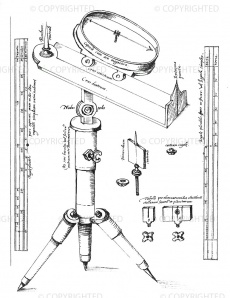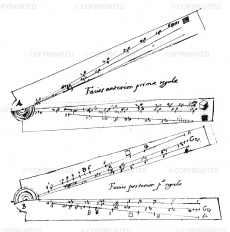Pantometer
From Inventions
| (6 intermediate revisions not shown) | |||
| Line 1: | Line 1: | ||
{{Template invention | {{Template invention | ||
| - | |nome= | + | |nome= |
| + | Name coined by the inventor (in Latin regula pantometra) | ||
| - | |descrizione= | + | |descrizione= |
| + | The "regula pantometra" is a [[Proportional Compasses | proportional compasses]] with flat legs designed by Michel Coignet for Archduke Albert, perhaps as early as 1596. The instrument clearly derives from the second version of Fabrizio Mordente's [["Compasso Magistrale" (Masterly Compasses) | "compasso magistrale" (masterly compasses)]] o (1572), but without the slots and cursors. In the two known manuscripts of ''De regulae pantometrae fabrica et usu libri septem'', the compass is described as essentially a surveying instrument, mounted on a tripod identical to the one proposed for Mordente's compass in the treatise on ''L'uso del compasso di Fabritio Mordente Salernitano..''. [The operation of the compass of Fabrizio Mordente from Salerno…], Antwerp 1608. The compass also had a folding ruler like that of Mordente's compass, and was fitted with optical sights that faithfully reproduced the fixed points of the model it emulated. Moreover, its surveying operations resembled those described in the treatise on Mordente's compass. Unlike the latter, however, Coignet's instrument has other proportional scales engraved on the legs, used to perform more complex operations in trigonometry: the scale of division into equal parts, the scale of cords and the scale of sines. | ||
|inventore= Michel Coignet | |inventore= Michel Coignet | ||
| Line 27: | Line 29: | ||
|immagini= <gallery widths=230 heights=368 perrow=3> | |immagini= <gallery widths=230 heights=368 perrow=3> | ||
| + | |||
| + | Image: 56698.jpg | Coignet, Michel. ''De Regulae Pantometrae fabrica et usu libri septem'', ms., Oxford.<br /> | ||
| - | Image: | + | Image: 56699.jpg | Coignet, Michel. ''Usus duodecim divisionem regulae pantometrae'', ms. 1610-1613, Firenze.<br /> |
| - | |||
| - | |||
</gallery> | </gallery> | ||
Current revision as of 08:16, 10 September 2010
Name coined by the inventor (in Latin regula pantometra)
Contents |
Inventor
Michel Coignet
Historic Period
1596?
Description
The "regula pantometra" is a proportional compasses with flat legs designed by Michel Coignet for Archduke Albert, perhaps as early as 1596. The instrument clearly derives from the second version of Fabrizio Mordente's "compasso magistrale" (masterly compasses) o (1572), but without the slots and cursors. In the two known manuscripts of De regulae pantometrae fabrica et usu libri septem, the compass is described as essentially a surveying instrument, mounted on a tripod identical to the one proposed for Mordente's compass in the treatise on L'uso del compasso di Fabritio Mordente Salernitano... [The operation of the compass of Fabrizio Mordente from Salerno…], Antwerp 1608. The compass also had a folding ruler like that of Mordente's compass, and was fitted with optical sights that faithfully reproduced the fixed points of the model it emulated. Moreover, its surveying operations resembled those described in the treatise on Mordente's compass. Unlike the latter, however, Coignet's instrument has other proportional scales engraved on the legs, used to perform more complex operations in trigonometry: the scale of division into equal parts, the scale of cords and the scale of sines.
Bibliographical Resources
Coignet, Michel. De Regulae Pantometrae fabrica et usu libri septem, ms., Oxford, Bodleian Library, Banon Misc. 243.
Coignet, Michel. Usus duodecim divisionem regulae pantometrae, ms. 1610-1613, Firenze, Biblioteca Riccardiana, 859.
Coignet, Michel. El uso del Compas Proporcional, ms., 1618, Napoli, Biblioteca Nazionale, MS. I.D.I.
Coignet, Michel. La geometrie reduite en un facile et briefve pratique; par deux excellens instrumens, dont l’une est le pantometre ou compas de proportion de Michel Connette ec. L’autre est l’usage du compas a huict poinctes inventé par Fabrice Mordente ec., Parigi, Charles Hulpeau, 1626.
Meskens, Ad. Michiel Coignet’s Contribution to the Development of the Sector, in «Annals of Science», 54 (1997), 2, pp. 143-160.
Images
Author of the entry: Filippo Camerota


